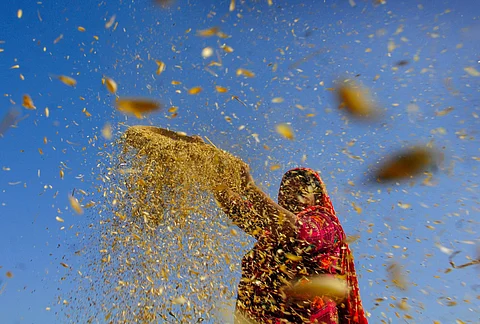

NEW DELHI: India's rice production could fall by 10-12 million tonnes during the Kharif season this year due to a fall in paddy sowing area, the government said on Friday, but asserted that it would still have surplus output.
On Thursday, the government imposed ban on exports of broken rice and also slapped an export duty of 20 per cent on non-basmati rice, except for parboiled rice, as its seeks to boost domestic supply and curb rising prices that have gone up by 8 per cent in wholesale market and 6 per cent in retail.
At a press conference to explain rationale behind the imposition of ban on exports of broken rice, Food Secretary Sudhanshu Pandey pointed out that the paddy acreage is lower by 38 lakh hectare so far this Kharif season because of less rains in many states.
The Kharif season contributes about 80 per cent of India's total rice production.
"Loss of production of rice maybe 10 million tonnes and in the worst case it can be 12 million tonnes this year," he told reporters here.
India's total rice production during 2021-22 crop year (July-June) is estimated at a record 130.29 million tonnes as against 124.37 million tonnes in the previous year. Out of total rice production in 2021-22, 111.76 million tonnes were in Kharif season and 18.53 million tonnes in Rabi (winter-sown) season.
The country exported 21.2 million tonnes of rice in 2021-22 fiscal year, of which 3.94 million tonnes were basmati rice.
The secretary, however, said that this is an initial estimate based on drop in paddy acreage in Kharif (summer-sown) and average yield and actual fall in production could be less as yield might improve in states where rains have been good.
As per the presentation made by Pandey, paddy sowing is lower by 25 lakh hectares in four states, which have witnessed deficient rains.
The production could be less by 7-8 million tonnes in these four states. In other states, paddy sowing has come down due to diversification to other crops.
Till September 2, area under the paddy crop was down by 5.62 per cent at 383.99 lakh hectare in the ongoing kharif season, according to the agriculture ministry data.
Paddy was sown in 406.89 lakh hectares in the year-ago period, the data showed. There was a huge lag in paddy sowing in the states of Jharkhand (9.80 lakh ha), Madhya Pradesh (6.32 lakh ha), West Bengal (4.45 lakh ha), Chhattisgarh (3.91 lakh ha), Uttar Pradesh (2.61 lakh ha), and Bihar (2.18 lakh ha) so far this kharif season.
Paddy is the main kharif crop and its sowing begins with the onset of the southwest monsoon from June and harvesting from October onwards.
Pandey did not reply to a question on whether the government would extend the free foodgrains programme Prime Minister Garib Kalyan Anna Yojana beyond September.
The PMGKAY scheme is valid till September and the government is yet to take a decision on whether to extend the welfare programme in the backdrop of tight stock situation with respect to wheat and likely fall in rice output.
Currently, the government is providing wheat and rice for Rs 2 per kg and Rs 3 per kg, respectively, under the National Food Security Law (NFSA).
The Centre is providing 5 kg of food grains (wheat and rice) per person per month under the NFSA to about 80 crore people.
Over an above the normal 5kg quota, the Centre provides an additional 5 kg foodgrain free of cost under the PMGKAY to around 80 crore people.
The Centre is sitting on a stock of 47 million tonnes of rice, including rice equivalent of unmilled paddy, as of July 1.
The buffer stock requirement is to have 13.5 million tonnes of rice as of July 1.
Already, the Centre is supplying more rice instead of wheat through ration shops as its procurement of wheat fell sharply to 19 million tonnes in 2022-23 marketing year compared to 43 million tonnes in the year-ago period.
Wheat marketing year is from April to March but almost the entire quantity of the grain is procured by the end of June.
In May, the government banned wheat exports amid marginal fall in wheat output and a sharp decline in procurement by state-run Food Corporation of India.